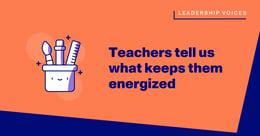
Predictions of an EdFinTech Expert: Jess Gartner, CEO of Allovue
Jess Gartner is the founder and CEO of Allovue. Allovue's software platform, Balance, helps educators budget, manage, and evaluate spending. Allovue also provides supplemental services, including funding equity analysis, diagnostic surveys, financial management training.
Jess has been featured as one of Forbes Magazine’s 30 Under 30 in Education, The Baltimore Sun’s Women to Watch, and Baltimore Magazine’s 40 Under 40. In 2014, she was recognized as the Maryland Smart CEO Innovator of the Year in the Emerging Business category.
In this interview, edited and condensed for clarity, Jess talks about the financial side of educational equity, the need to make the internet a public utility, and how her organization is helping districts plan for revenue changes as a consequence of the crisis.
Can you tell us a bit about your background and your journey to Allovue?
I started my career academically studying education policy. After college, I moved down to Baltimore and did my masters in teaching at Johns Hopkins and taught Middle School Language Arts and social studies for Baltimore City Public Schools. During my time teaching, I had a pretty wide array of experiences at different schools as it related to the resources that I had to do my job. Everything ranging from “is there enough copy paper” to “is the school going to equip us with the right textbooks and reading books or do I need to go try to procure those myself somewhere” and then there were also schools in the district that had 1:1 programs.
There were very different resource profiles from one school to another. I really started thinking about that in the context of the gaps that we see in learning outcomes and started thinking about the other side of the equation.
We talked a lot about outcomes, whether that's teacher effectiveness or student performance or graduation rates, but we weren't talking as much about the inputs and the potential resource inequities.
In the time since we founded the company, we have seen that there are in fact very severe inequities in how dollars and other resources reach students across race and socioeconomic lines. Part of our mission as a company is to help school districts make more strategic choices more efficiently about their budgets and their spending and really give them some modern tools to be able to do that. But a lot of our work also goes through the lens of equity and ensuring that as you are allocating resources to schools and to classrooms that you're thinking about the equity of those resources and ensuring that every student is getting what they need to be successful.
What does the new normal look like for you folks?
Many of our partners are still in the thick of their budget season right now and are still proceeding as normal trying to build their budgets for next year— although they are starting to factor in some scenarios in terms of how their revenue may be impacted from the economic downturn and I think we'll see the effects of that for several years to come. School districts were just in the last year or two starting to get on the other side of the cuts from the 2008 recession. They have lived through these economic downturns before and they know that the downstream effects on Federal and State funding and from their local tax funding can be pretty severe. So districts are certainly starting to think through that.
However, and this is where our new free tools and services come into play, there are obviously some short-term urgent needs as it relates to deploying and tracking resources. So many school districts are trying to spin up on distance or remote learning programs virtually overnight. This is a type of initiative that would normally take probably years of preparation and training and planned purchasing and procurement and districts are now trying to spin up these models in a matter of a week or two now that we're seeing that students are likely not going to return to school this school year.
So we are seeing things like school districts going and buying 18,000 to 20,000 Chromebooks overnight or a hundred thousand headphone sets or trying to procure other services and curricular resources to facilitate remote learning. Those have huge consequences on the budget. In a normal time something like the purchase of 20,000 devices would probably warrant years of thinking and planning and reviewing and some of these purchases are being made very quickly, so those are obviously huge and unanticipated costs. There were some stimulus funds in the CARES act already earmarked for education and I expect that there will be some more for these urgent purchases related to dealing with disaster relief. And to that end, it is very likely that districts will have to report detailed accounts and detailed records of what they purchased as a COVID response.
We are repurposing some of our tools and also creating some new free tools to make it very easy for districts to track those requests and purchases as it relates to their relief and response efforts.
It’s great to see that districts are now procuring devices and hotspots to students to facilitate remote learning, but equity gaps have always existed. What has stopped districts from doing this in the past, before the pandemic?
It's been fascinating to see some of the rhetoric around how this experience is “exposing” the digital divide because I think anyone who has worked in or tangentially to education has known that this has been a persistent and pervasive inequity for a very long time. I do think some of the cost and the political will around some of these investments have been a huge barrier. These are not inexpensive investments and when you're talking about something like a Chromebook device, the cost does not end with the device, particularly if you were thinking about this in a normal school-year setting. You have to worry about the initial cost of the device, storage, charging, what happens when something breaks, service, support, privacy, maintenance, etc.
And then you have to think about: “Are there additional costs for software for ebooks? Are there trade-offs? Are we going to stop buying our typical textbooks and move to more digital learning resources?” And then beyond that, the teaching and instructional and assessment implications are far-reaching as well. I mean there's obviously a very different teaching experience and whole toolkit of instructional tools that you need to be trained on. One, to manage your classroom with digital and e-learning resources versus your traditional textbooks and notebooks, and two, to make it so that the device does not just become a digital notebook, but that you're really elevating the potential for that device and the learning opportunities that come with that.
There's just so much wrapped up in a normal e-learning experience and even in normal times the cost is then not even limited to in-school instruction. But how do you account for the fact that 60 to 70% of your kids may not have internet access at home? So then you can't assign homework or assignments that require accessing the internet at home unless you're going to plan to also buy internet services or hotspots for all of your kids. In normal times there just has not been the political will to make this investment— as a society, we have been okay with leaving these inequities lurking beneath the surface.
There are many school districts and private schools in this country for whom this transition happened overnight because they've been doing a lot of digital learning for years. And so to add a couple of Zoom classes was not a huge lift for them. If you think about the inequity of that in terms of learning loss, we have talked to parents and teachers and principals for whom they were like, “Oh, yeah, we just sent the kids home with their devices that they've been using for 10 years and now they do math on Zoom instead”. You compare that to school districts, who are starting completely from scratch on this. These equity issues will be compounded in a very serious way.
Once the pandemic is over, what do you think the impact of school closures will be on education?
I am largely an optimist by nature. I think most entrepreneurs have to be. So the optimist in me hopes that we recognize that it is not acceptable for people to not have access to the internet, that it needs to become a public utility. In a scenario like this especially, but even in normal day-to-day, the way that our society functions right now, having home internet access is just about as important as water and electricity and other things you need to function in society.
I do hope that we keep having the conversation about how we make the internet a public utility moving forward and ensure that there is widespread universal access to the Internet. That would go a very long way towards closing some of these digital divide gaps.
As it relates to the devices piece, I think there are other situations where this type of learning can be beneficial to students. If you think about your average snow day, if we actually had a system in place where districts and students and parents could transition to online instruction for days, we could probably eliminate the need to shut down for snow days. Or there are other emergency situations where we don't necessarily need to shut down schools for two months, but, even a day or two or three here and there can add up to a substantial amount of instruction. So I think there are certainly some benefits there to having the infrastructure to be able to do that.
The part that deeply concerns me is how students with disabilities will be impacted by this. In the short-term, districts are certainly doing what they can to provide the highest levels of instruction for most kids in this emergency situation. However, I think that looking forward and planning for remediation and recovery as we do get back to school and assessing the inequitable impact of this learning loss will have to be considered with a particular focus for students with disabilities who may be going weeks or months without the services that they are by law required to receive. As we're thinking through the “what if we made this part of our normal disaster and emergency planning”, a lot more thought has to be given to how we continue to uphold our legal and moral obligation to ensure that these systems work for all students, particularly our most vulnerable students.
That's such a great point. We've seen that there are so many different bases of support for schools to cover, that students with disabilities are getting pushed to the side a little bit with distance learning.
Yeah, and on that point, in terms of the far-reaching effects of this, another optimistic hope I have is that this is really shining a light on how many essential services school districts provide for students, families, communities, and the economy. I mean if you think about the fact that school districts are spinning up meal centers around their communities and still managing to feed kids and in some cases their families as well with one, two, three meals a day— that is remarkable. But that is also a massive expectation that we put on school districts that I think has gone long underappreciated. We are already starting to see some very disturbing spikes in child abuse. So I think about how schools provide a safe place and social welfare resources and then even just the fact that so many parents and communities are struggling right now without the services of schools and teachers.
I really do hope that there comes a greater respect for truly what a challenging profession education is, whether that's teachers or social workers or principals. I do hope there is some long-standing appreciation and heightened professionalism as people realize just how difficult it really is to teach a kid to read, or get them to do their math homework or help them understand how fractions work. These are not simple things and great teachers are so undervalued. I hope that people start to recognize just how specialized those skills really are and how important they are to the entire framework of our economy and society.
How Allovue is helping districts during COVID-19
Allovue is providing free offerings to help school districts. Our Community Allocation Response Team Services (CARTS) can help districts procure and deliver resources to students and staff during closures, model resource allocation scenarios to prepare for revenue changes as a consequence of the crisis, and provide guidance to help districts decide what happens next.






